A Deep Learning Framework for Evaluating the Over-the-Air Performance of the Antenna in Mobile Terminals
Abstract
1. Introduction
- The proposed framework introduces a novel antenna performance prediction model, which can be used for preliminary assessment of SAR and EIRP while reducing the number of repetitive simulations with commercial software on the specialized computational platform;
- The study converts the features of the antenna and the internal components of the mobile phone into a near-field EMF distribution on the Huygens’ box, which simplifies the input of the DL model;
- A DL model based on the divide-and-conquer method [15] is proposed. It divides the estimation for SAR and EIRP into eight modules, reducing the training complexity and enhancing the convergence rate;
2. The Proposed Method
2.1. The Workflow of the Proposed Method
- A phone in FS;
- A phone mounted in the “cheek” position on the head phantom (this includes the “cheek” position for both the left and right ears);
- PDA (Personal Digital Assistant) grip in “data” mode (for both the left and right hand);
- “Talk” mode (which includes configurations for the left and right head and hand).
- Additionally, four SAR evaluation configurations are created, including:
- The cheek (left and right) positions of the phone against the Specific Anthropomorphic Mannequin (SAM) phantom;
- Tilt (left and right) positions of the phone against the SAM phantom.
2.2. RTEEMF-PhoneAnts Architecture
3. Experiment Configurations
3.1. Dataset Generation
3.2. Data Preprocessing for RTEEMF-PhoneAnts
3.3. Training Configurations for RTEEMF-PhoneAnts
3.4. Evaluation Criteria and Numerical Validation
4. Experiment Results
4.1. Performance of the Proposed Model
4.2. Efficiency of the Proposed Model
4.3. Model Generalization across Diverse Antenna Types
5. Conclusions
Author Contributions
Funding
Institutional Review Board Statement
Informed Consent Statement
Data Availability Statement
Conflicts of Interest
Abbreviations
| RTEEMF-PhoneAnts | Real-Time Evaluation Electromagnetic Field–Phone Antennas | DL | Deep Learning |
| NEMF | Near-field Electromagnetic Field | EMF | Electromagnetic Field |
| EIRP | Effective Isotropic Radiated Power | TRP | Total Radiated Power |
| SAR | Specific Absorption Rate | WBSAR | Whole-Body Average SAR |
| SAR-1g | averaged peak SAR in 1g | SAR-10g | averaged peak SAR in 10g |
| WSR | Wilcoxon Signed Rank Test | FSV | Feature Selection Validation Method |
| R&D | Research and Development | CTIA | Cellular Telecommunications and Internet Association |
| IEC | International Electrotechnical Commission | IEEE | Institute of Electrical and Electronics Engineers Engineers |
| CAD | Computer-Aided Design | FS | Free Space |
| FDTD | Finite Difference Time Domain | PDA | Personal Digital Assistant |
| SAM | Specific Anthropomorphic Mannequin | IFAs | Inverted-F Antennas |
| PIFAs | Printed IFAs | Ant | Antenna |
| RMSE | Root Mean Squared Error | RMS | Root Mean Square |
| SS | Stratified Sampling | LOAO | Leave-One-Antenna-Out |
| ADM | Amplitude Difference Measure | FDM | Feature Difference Measure |
| GDM | Global Difference Measure | 3GPP | 3rd Generation Partnership Project |
| UE | User Equipment | UL | Uplink |
| OLED | Organic Light-Emitting Diode |
References
- CTIA Certification. Test Plan for Wireless Device Over-the-Air Performance: Method of Measurement for Radiated RF Power and Receiver Performance; CTIA Certification 3.8.2; CTIA Certification: Washington, DC, USA, 2019. [Google Scholar]
- IEC/IEEE 62704-1:2017; Determining the Peak Spatial-Average Specific Absorption Rate (SAR) in the Human Body from Wireless Communications Devices, 30 MHz to 6 GHz—Part 1: General Requirements for Using the Finite-Difference Time-Domain (FDTD) Method for SAR Calculations. IEC/IEEE International Standard: Piscataway, NJ, USA, 2017.
- IEC/IEEE 62704-2:2017; Determining the Peak Spatial-Average Specific Absorption Rate (SAR) in the Human Body from Wireless Communications Devices, 30 MHz to 6 GHz—Part 2: Specific Requirements for Finite Difference Time Domain (FDTD) Modelling of Exposure from Vehicle Mounted Antennas. IEEE/IEC International Standard: Piscataway, NJ, USA, 2017.
- IEC/IEEE 62209-1528:2020; Measurement Procedure for the Assessment of Specific Absorption Rate of Human Exposure to Radio Frequency Fields from Hand-Held and Body-Mounted Wireless Communication Devices—Part 1528: Human Models, Instrumentation, and Procedures (Frequency Range of 4 MHz to 10 GHz). IEC/IEEE International Standard: Piscataway, NJ, USA, 2020.
- Li, C.; Yang, L.; Wu, T. Predicting Over-the-Air Performance Using a Hand Phantom with Large Dielectric Flexibility. IEEE Trans. Electromagn. Compat. 2021, 63, 1699–1708. [Google Scholar] [CrossRef]
- Li, C.; Wu, T. Efficient Evaluation of Incident Power Density by Millimeter-Wave MIMO User Equipment Using Vectorized Field Superposition and Stochastic Population Optimizers. IEEE Trans. Electromagn. Compat. 2023, 65, 1090–1097. [Google Scholar] [CrossRef]
- Wu, T.; Chen, Y.; Li, C. Efficient Evaluation of Epithelial/Absorbed Power Density by Multi-Antenna User Equipment with SAM Head Model. IEEE Antennas Wirel. Propag. Lett. 2024, 1–5. [Google Scholar] [CrossRef]
- Koziel, S.; Dabrowska, A.P. Performance-Based Nested Surrogate Modeling of Antenna Input Characteristics. IEEE Trans. Antenn. Propag. 2019, 67, 2904–2912. [Google Scholar] [CrossRef]
- Zhai, M.; Chen, Y.; Xu, L.; Yin, W.Y. An End-to-End Neural Network for Complex Electromagnetic Simulations. IEEE Antennas Wirel. Propag. Lett. 2023, 22, 2522–2526. [Google Scholar] [CrossRef]
- Khan, M.M.; Hossain, S.; Mozumda, P.; Akte, S.; Ashique, R.H. A review on machine learning and deep learning for various antenna design applications. Heliyon 2022, 8, e09317. [Google Scholar] [CrossRef]
- Love, A. The integration of the equations of propagation of electric waves. Phil. Trans. Roy. Soc. London Ser. A 1901, 197, 1–45. [Google Scholar]
- Scialacqua, L.; Mioc, F.; Scannavini, A.; Foged, L.J. Simulated and Measured Power Density using Equivalent Currents for 5G applications. In Proceedings of the 2020 IEEE International Symposium on Antennas and Propagation and North American Radio Science Meeting, Montreal, QC, Canada, 5–10 July 2020. [Google Scholar] [CrossRef]
- Eibert, T.F.; Kiliç, E.; Lopez, C.; Mauermayer, R.A.; Neitz, O.; Schnattinger, G. Electromagnetic Field Transformations for Measurements and Simulations (Invited Paper). Prog. Electromagn. Res. 2015, 151, 127–150. [Google Scholar] [CrossRef]
- Wang, H. Overview of Future Antenna Design for Mobile Terminals. Engineering 2022, 11, 12–14. [Google Scholar] [CrossRef]
- Li, C.; Yao, G.; Xu, X.; Yang, L.; Zhang, Y.; Wu, T.; Sun, J. DCSegNet: Deep Learning Framework Based on Divide-and-Conquer Method for Liver Segmentation. IEEE Access 2020, 8, 146838–146846. [Google Scholar] [CrossRef]
- Noether, G.E. Introduction to Wilcoxon (1945) individual comparisons by ranking methods. In Breakthroughs in Statistics: Methodology and Distribution; Springer: New York, NY, USA, 1992; pp. 191–195. [Google Scholar]
- Duffy, A.P.; Martin, A.J.; Orlandi, A.; Antonini, G.; Benson, T.M.; Woolfson, M.S. Feature selective validation (FSV) for validation of computational electromagnetics (CEM). part I-the FSV method. IEEE Trans. Electromagn. Compat. 2006, 48, 449–459. [Google Scholar] [CrossRef]
- Liu, Z.; Hall, P.S.; Wake, D. Dual-frequency planar inverted-F antenna. IEEE Trans. Antenn. Propag. 1997, 10, 1451–1458. [Google Scholar]
- Khlouf, M.M.; Azemi, S.N.; Al-Hadi, A.A.; Soh, P.J.; Jamlos, M.F. Dual Band Planar Inverted F Antenna (PIFA) with L-Shape Configuration. MATEC Web Conf. 2017, 140, 01019. [Google Scholar] [CrossRef]
- Wang, H.; Zheng, M. A Triple-Band WLAN Monopole Antenna. In Proceedings of the Second European Conference on Antennas and Propagation, EuCAP 2007, Edinburgh, Scotland, UK, 11–16 November 2007. [Google Scholar]
- Wang, H.; Zheng, M.; Zhang, S.; Johnson, A. Monopole Slot Antenna. United States Patent US 661 8020B2, 2003.
- Zheng, M.; Wang, H.; Hao, Y. Internal Hexa-Band Folded Monopole/Dipole/Loop Antenna with Four Resonances for Mobile Device. IEEE Trans. Antenn. Propag. 2012, 60, 2880–2885. [Google Scholar] [CrossRef]
- Rowell, C.; Lam, E.Y. Mobile-Phone Antenna Design. IEEE Antennas Propag. Mag. 2021, 54, 14–34. [Google Scholar] [CrossRef]
- Zhang, Z. Antenna Design for Mobile Devices; Wiley–IEEE Press: Piscataway, NJ, USA, 2017. [Google Scholar]
- Chen, Z. Antennas for Portable Devices; John Wiley & Sons, Inc.: New York, NY, USA, 2007. [Google Scholar]
- Jeong, S.; Cho, B.; Kwak, Y.S.; Byun, J.; Kim, A.S. Design and analysis of multi-band antenna for mobile handset applications. In Proceedings of the 2009 IEEE Antennas and Propagation Society International Symposium, North Charleston, SC, USA, 1–5 June 2009. [Google Scholar]
- Li, Y.; Zhang, Z.; Zheng, J.; Feng, Z. Compact Heptaband Reconfigurable Loop Antenna for Mobile Handset. IEEE Antennas Wirel. Propag. Lett. 2011, 10, 1162–1165. [Google Scholar] [CrossRef]
- Zuo, S.; Zhang, Z.; Xie, J. Design of dual-monopole slots antenna integrated with monopole strip for wireless wide area network mobile handset. IET Microw. Antenna Propag. 2014, 8, 194–199. [Google Scholar] [CrossRef]
- Singh, D.; Singh, B. Investigating the impact of data normalization on classification performance. Appl. Soft. Cmput. 2020, 97, 105524. [Google Scholar] [CrossRef]
- Duffy, A.; Zhan, G. FSV: State of the art and current research fronts. IEEE Electromagn. Compat. Mag. 2020, 9, 55–62. [Google Scholar] [CrossRef]
- Bongiorno, J.; Mariscotti, A. Uncertainty and Sensitivity of the Feature Selective Validation (FSV) Method. Electronics. 2022, 11, 2532. [Google Scholar] [CrossRef]
- 3rd Generation Partnership Project (3GPP). Evolved Universal Terrestrial Radio Access (E-UTRA). In User Equipment (UE) Radio Transmission and Reception; 36.101 V18.5.0; 3GPP: Sophia Antipolis, France, 2024. [Google Scholar]
- Li, C.; Xu, C.; Wang, R.; Wu, T. Numerical evaluation of human exposure to 3. 5-GHz electromagnetic field by considering the 3GPP-like channel features. Ann. Telecommun. 2019, 74, 25–33. [Google Scholar] [CrossRef]
- Yuan, X. The Case for Electromagnetic Simulation in Mobile Antenna Design; TECHNICAL PAPER; KYOCERA AVX Components Corporation: Fountain Inn, SC, USA, 2024. [Google Scholar]
- Cenci, M.P.; Eidelwein, E.M.; Scarazzato, T.; Veit, H.M. Assessment of smartphones’ components and materials for a recycling perspective: Tendencies of composition and target elements. J. Mater. 2024, 26, 1379–13931. [Google Scholar] [CrossRef]

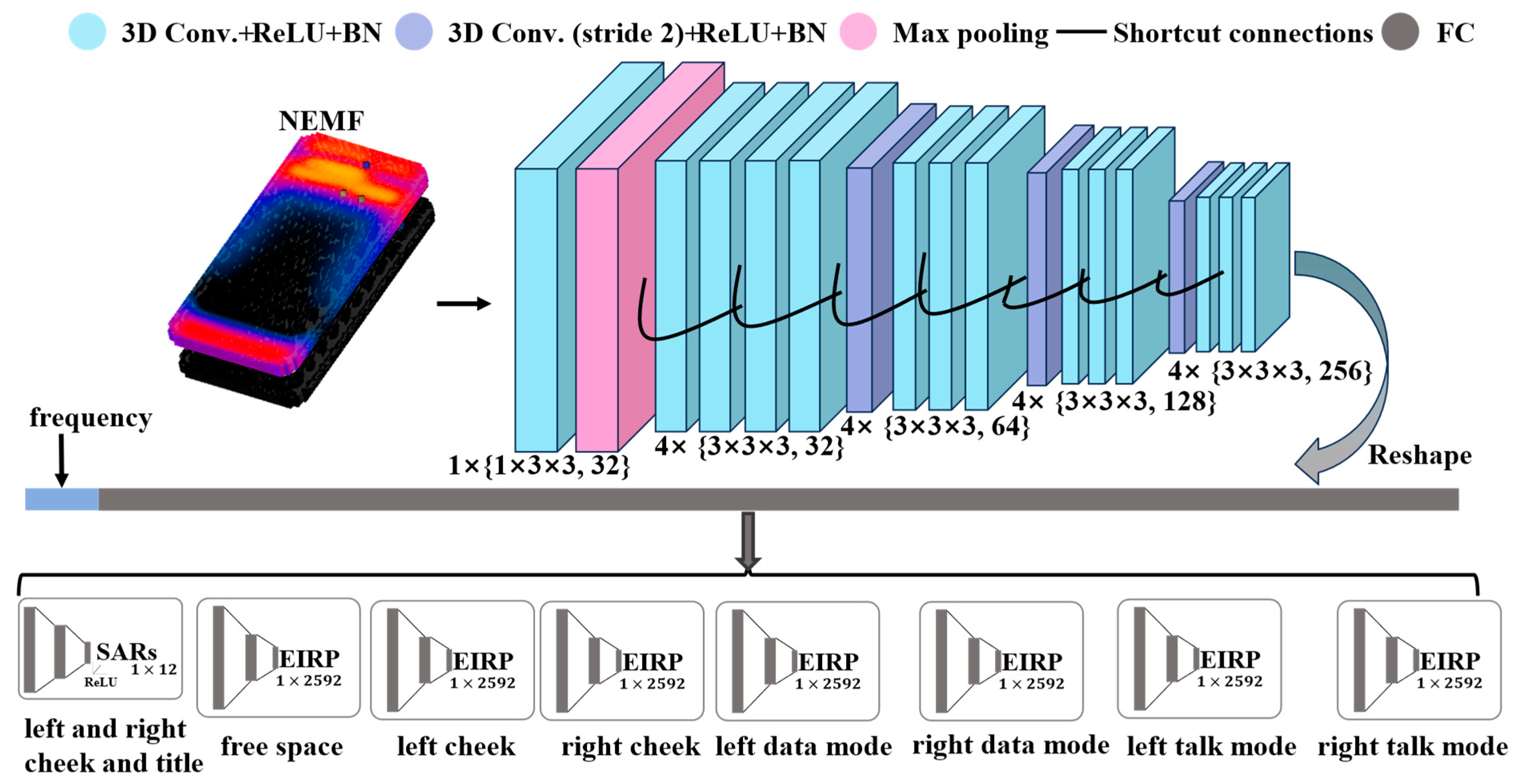

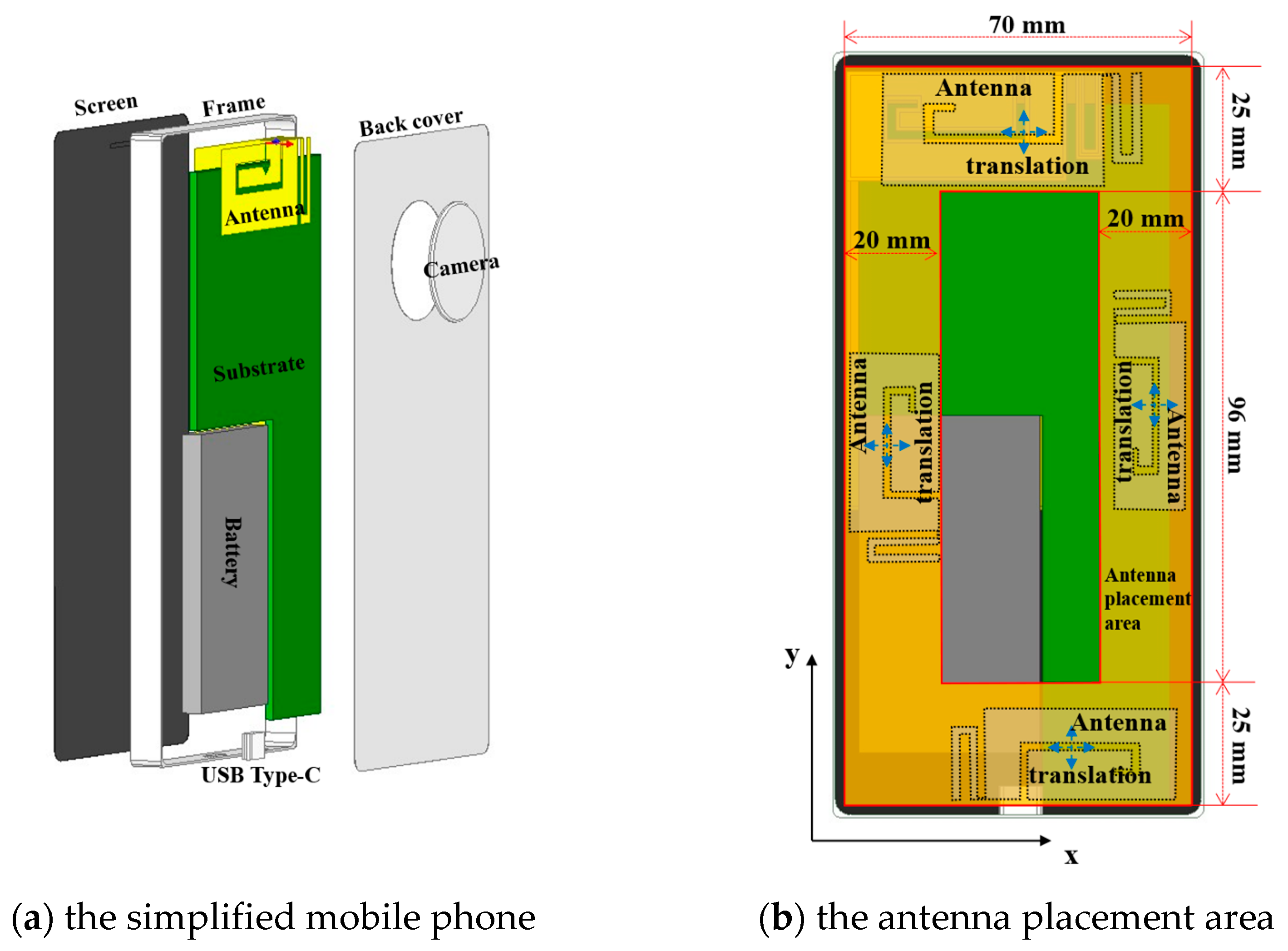


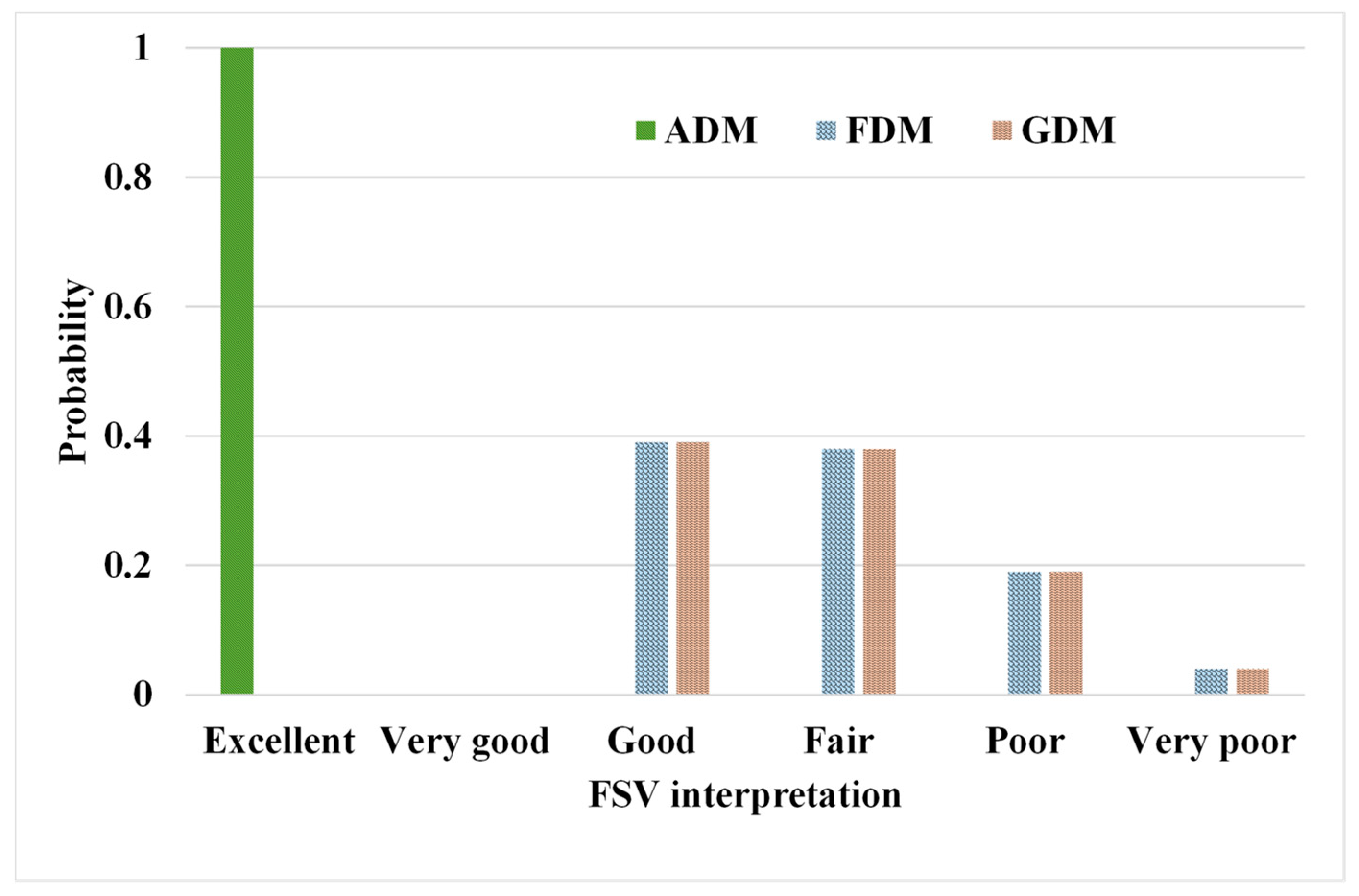
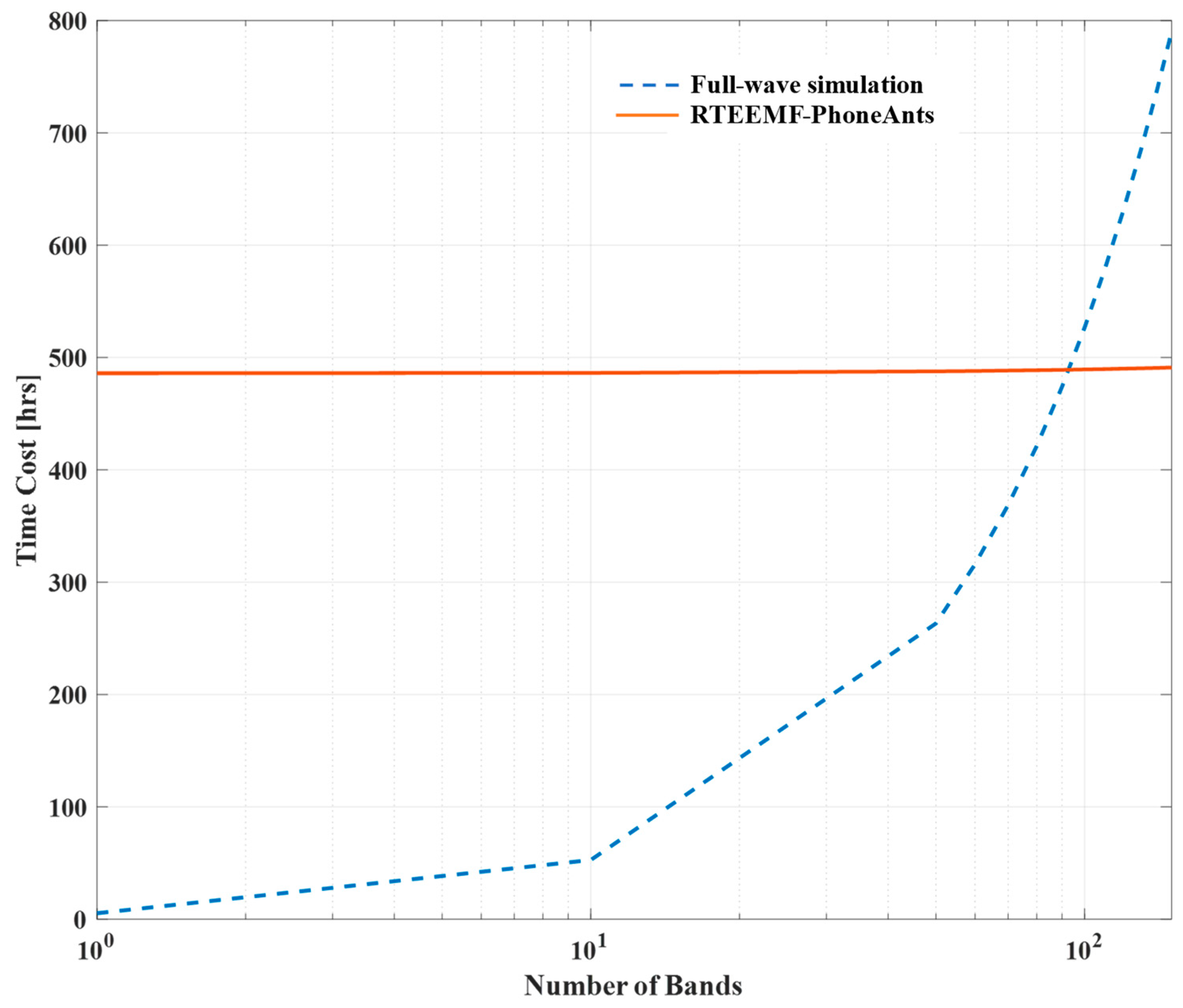
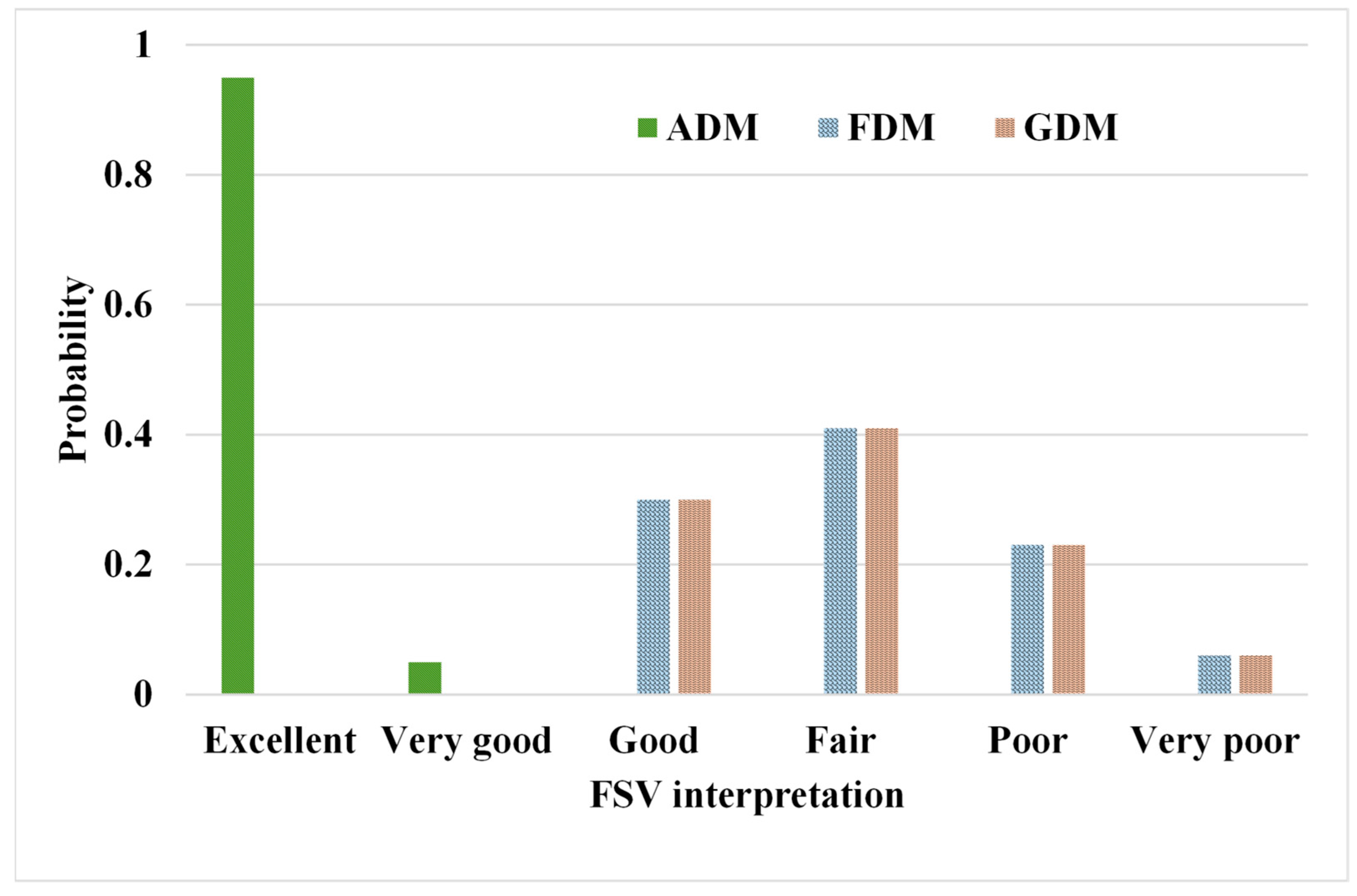
| fre (MHz) | Bands | Ant. | |||||
|---|---|---|---|---|---|---|---|
| 1 | 2 | 3 | 4 | 5 | 6 | ||
| 850 | GSM850,WCDMA | √ | √ | √ | √ | √ | √ |
| 900 | GSM900,UMTS900 | √ | √ | √ | √ | √ | √ |
| 1800 | GSM1800, WCDMA,FDD-LTE | √ | √ | √ | √ | √ | √ |
| 1900 | GSM1900,TD-SCDMA,TDD-LTE | √ | √ | √ | √ | √ | √ |
| 2000 | TD-SCDMA | √ | √ | √ | √ | √ | |
| 2100 | WCDMA,CDMA2000 | √ | √ | √ | √ | √ | √ |
| 2600 | TDD-LTE | √ | √ | √ | |||
| Number of antennas | 10 | 1 | 1 | 7 | 1 | 14 | |
| Number of samples | 2400 | 200 | 220 | 1600 | 180 | 2400 | |
| Configurations | 25th Percentile | 75th percentile | Z-Value | p-Value | ||||
|---|---|---|---|---|---|---|---|---|
| SEMCAD | RTEEMF-PhoneAnts | SEMCAD | RTEEMF-PhoneAnts | |||||
| “cheek” position (W/kg) | left | WBSAR | 0.05 | 0.05 | 0.13 | 0.12 | −0.20 | 0.84 |
| SAR-1g | 6.35 | 6.74 | 20.43 | 20.84 | −0.06 | 0.95 | ||
| SAR-10g | 1.81 | 1.79 | 13.66 | 13.78 | −1.77 | 0.08 | ||
| right | WBSAR | 0.05 | 0.05 | 0.13 | 0.13 | −0.71 | 0.48 | |
| SAR-1g | 14.50 | 13.31 | 38.40 | 40.35 | −0.20 | 0.84 | ||
| SAR-10g | 7.70 | 7.40 | 16.99 | 16.65 | −0.22 | 0.83 | ||
| “tilt” position (W/kg) | left | WBSAR | 0.06 | 0.06 | 0.13 | 0.13 | −0.20 | 0.84 |
| SAR-1g | 2.18 | 2.26 | 13.89 | 15.11 | −0.59 | 0.56 | ||
| SAR-10g | 1.27 | 1.27 | 5.80 | 5.92 | −1.07 | 0.29 | ||
| right | WBSAR | 0.06 | 0.06 | 0.13 | 0.12 | −0.82 | 0.41 | |
| SAR-1g | 7.92 | 7.41 | 23.37 | 20.89 | 0.00 | 1.00 | ||
| SAR-10g | 2.15 | 2.03 | 8.30 | 8.05 | −0.47 | 0.64 | ||
| free space (dB) | TRP | 2.53 | 1.69 | 3.56 | 3.91 | 0.00 | 1.00 | |
| “cheek” position (dB) | left | TRP | −6.02 | −5.04 | −0.08 | −0.04 | 0.00 | 1.00 |
| right | TRP | −5.59 | −5.42 | 0.10 | 0.11 | −1.37 | 0.17 | |
| “data” mode (dB) | left | TRP | 0.32 | 0.18 | 1.65 | 1.55 | −1.77 | 0.08 |
| right | TRP | −0.36 | −0.33 | 1.80 | 1.96 | 0.00 | 1.00 | |
| “talk” mode (dB) | left | TRP | −0.34 | −0.34 | 2.00 | 1.95 | −0.63 | 0.53 |
| right | TRP | −8.70 | −8.43 | −4.37 | −2.93 | −1.37 | 0.17 | |
| Configurations | Time Cost (min) | ||||
|---|---|---|---|---|---|
| Full-Wave Simulation for One Band | RTEEMF-PhoneAnts | ||||
| Position of Phone | Simulation | Training (Number of Training Data = 7000, Batch Size = 4, Epoch = 200) | Inference (Batch Size = 1) | ||
| SAR evaluation | Left cheek | 0.5 | 20 | 29,167 | 2.025 |
| Left tilt | 2 | 24 | |||
| Right cheek | 0.5 | 20 | |||
| Right tilt | 2 | 24 | |||
| OTA evaluation | Phone in free space | 0 | 2 | ||
| Left cheek | 0 | 0 | |||
| Right cheek | 0 | 0 | |||
| Left hand in “data” mode | 3 | 30 | |||
| Right hand in “data” mode | 3 | 30 | |||
| Left hand and head in “talk” mode | 4 | 65 | |||
| Right hand and head in “talk” mode | 4 | 65 | |||
| Configurations | Mean ± Std of Deviation (%), | ||||||||
|---|---|---|---|---|---|---|---|---|---|
| Stratified Sampling | Leave-One-Antenna-Out | ||||||||
| Ant.1 | Ant.2 | Ant.3 | Ant.4 | Ant.5 | Ant.6 | ||||
| “cheek” position | left | WBSAR | 5.84 ± 2.52 | 6.35 ± 4.25 | 7.82 ± 4.61 | 4.97 ± 4.07 | 9.5 ± 3.66 | 8.51 ± 3.58 | 9.06 ± 3.94 |
| SAR-1g | 5.71 ± 2.84 | 5.99 ± 5.59 | 5.98 ± 3.87 | 5.75 ± 3.36 | 8.25 ± 3.14 | 5.76 ± 4.52 | 8.85 ± 3.61 | ||
| SAR-10g | 3.71 ± 0.28 | 5.3 ± 0.43 | 3.73 ± 0.46 | 3.71 ± 0.5 | 4.33 ± 0.56 | 4.58 ± 0.39 | 5.76 ± 0.55 | ||
| right | WBSAR | 4.93 ± 2.29 | 6.63 ± 4.04 | 5.09 ± 3.05 | 5.54 ± 2.74 | 8.74 ± 2.95 | 5.26 ± 3.41 | 7.64 ± 4.25 | |
| SAR-1g | 2.15 ± 0.75 | 2.5 ± 1.09 | 3.61 ± 1.18 | 2.68 ± 1.12 | 3.92 ± 1.19 | 3.61 ± 1.02 | 3.34 ± 0.77 | ||
| SAR-10g | 3.22 ± 1.88 | 3.82 ± 2.81 | 3.24 ± 2.25 | 3.7 ± 2.09 | 5.7 ± 3.76 | 4.36 ± 2.53 | 4.99 ± 2.99 | ||
| “tilt” position | left | WBSAR | 5.26 ± 2.63 | 6.07 ± 2.84 | 7.36 ± 4.21 | 7.76 ± 4.72 | 9.69 ± 4.82 | 7.51 ± 3.59 | 8.16 ± 3.61 |
| SAR-1g | 7.17 ± 3.97 | 10.5 ± 4.67 | 7.35 ± 5.48 | 7.28 ± 4.23 | 9.98 ± 5.25 | 7.71 ± 7.8 | 11.11 ± 4.69 | ||
| SAR-10g | 6.04 ± 2.96 | 7.97 ± 4.7 | 7.35 ± 3.52 | 6.97 ± 4.15 | 10.86 ± 4.6 | 7.39 ± 4.29 | 9.36 ± 3.32 | ||
| right | WBSAR | 3.46 ± 1.83 | 4.61 ± 2.93 | 5.57 ± 2.51 | 4.03 ± 2.23 | 4.35 ± 1.97 | 4.21 ± 3.27 | 5.36 ± 2.93 | |
| SAR-1g | 6.09 ± 2.88 | 8.43 ± 4.97 | 8.21 ± 3.9 | 8.31 ± 4.13 | 9.79 ± 4.1 | 7.21 ± 5.03 | 9.44 ± 3.22 | ||
| SAR-10g | 5.07 ± 2.8 | 6.32 ± 4.25 | 6.22 ± 5.24 | 6.78 ± 3.37 | 7.86 ± 5.49 | 6.67 ± 2.91 | 7.86 ± 4.48 | ||
| free space | TRP | 0.24±0.12 | 1.91 ± 0.93 | 2.49 ± 1.16 | 2.97 ± 1.04 | 2.15 ± 1.31 | 2.1 ± 1.03 | 3.32 ± 1.56 | |
| “cheek” position | left | TRP | 3.92 ± 1.16 | 5.26 ± 1.82 | 5.24 ± 1.95 | 4.09 ± 2.05 | 6.92 ± 2.32 | 4.08 ± 2.05 | 6.08 ± 2.24 |
| right | TRP | 3.48 ± 1.55 | 4.78 ± 3.08 | 3.75 ± 2.66 | 4.76 ± 2.24 | 4.8 ± 2.22 | 4.47 ± 1.67 | 5.4 ± 2.2 | |
| “data” mode | left | TRP | 1.9 ± 1.18 | 2.22 ± 2.17 | 3.05 ± 2.11 | 2.8 ± 1.22 | 3.39 ± 2.05 | 2.97 ± 1.58 | 2.95 ± 1.78 |
| right | TRP | 1.81 ± 0.82 | 2.35 ± 1.53 | 2.83 ± 1.45 | 2.13 ± 1.41 | 2.06 ± 1.4 | 2.09 ± 1.29 | 2.8 ± 1.09 | |
| “talk” mode | left | TRP | 2.87 ± 1.37 | 3.71 ± 1.73 | 2.98 ± 2.35 | 3.05 ± 1.46 | 3.43 ± 2.17 | 3.89 ± 2.09 | 4.44 ± 2.55 |
| right | TRP | 7.88 ± 4.49 | 9.41 ± 8.72 | 8.79 ± 6.11 | 8.54 ± 6.72 | 9.83 ± 7.93 | 7.93 ± 8.16 | 12.21 ± 8.4 | |
| Configurations | 25th Percentile | 75th Percentile | Z-Value | p-Value | ||||
|---|---|---|---|---|---|---|---|---|
| SEMCAD | RTEEMF-PhoneAnts | SEMCAD | RTEEMF-PhoneAnts | |||||
| “cheek” position (W/kg) | left | WBSAR | 0.04 | 0.05 | 0.13 | 0.13 | −1.34 | 0.18 |
| SAR-1g | 13.05 | 13.34 | 41.37 | 42.90 | −0.42 | 0.68 | ||
| SAR-10g | 5.92 | 5.97 | 18.50 | 18.06 | −0.39 | 0.69 | ||
| right | WBSAR | 0.02 | 0.02 | 0.08 | 0.08 | −0.77 | 0.44 | |
| SAR-1g | 1.75 | 1.71 | 13.88 | 13.57 | −0.67 | 0.50 | ||
| SAR-10g | 1.13 | 1.20 | 7.97 | 7.67 | −0.22 | 0.83 | ||
| “tilt” position (W/kg) | left | WBSAR | 0.05 | 0.06 | 0.13 | 0.13 | −0.72 | 0.47 |
| SAR-1g | 13.56 | 13.55 | 35.55 | 34.76 | −0.98 | 0.33 | ||
| SAR-10g | 7.36 | 7.54 | 17.04 | 18.10 | −2.37 | 0.02 | ||
| right | WBSAR | 0.02 | 0.02 | 0.08 | 0.08 | −1.13 | 0.26 | |
| SAR-1g | 2.27 | 2.16 | 14.37 | 14.24 | −0.38 | 0.70 | ||
| SAR-10g | 1.27 | 1.34 | 8.18 | 7.61 | −0.44 | 0.66 | ||
| free space (dB) | TRP | 2.99 | 2.92 | 3.60 | 3.73 | −0.04 | 0.97 | |
| “cheek” position (dB) | left | TRP | −6.43 | −6.89 | −0.09 | −0.09 | −0.05 | 0.96 |
| right | TRP | −5.95 | −5.37 | 0.11 | 0.11 | −1.66 | 0.10 | |
| “data” mode (dB) | left | TRP | 0.37 | 0.32 | 1.72 | 1.79 | −1.17 | 0.24 |
| right | TRP | −0.35 | −0.34 | 2.40 | 2.36 | −1.09 | 0.28 | |
| “talk” mode (dB) | left | TRP | −0.33 | −0.34 | 2.36 | 2.25 | −0.17 | 0.86 |
| right | TRP | 4.64 | 4.43 | 9.11 | 8.02 | −0.16 | 0.87 | |
Disclaimer/Publisher’s Note: The statements, opinions and data contained in all publications are solely those of the individual author(s) and contributor(s) and not of MDPI and/or the editor(s). MDPI and/or the editor(s) disclaim responsibility for any injury to people or property resulting from any ideas, methods, instructions or products referred to in the content. |
© 2024 by the authors. Licensee MDPI, Basel, Switzerland. This article is an open access article distributed under the terms and conditions of the Creative Commons Attribution (CC BY) license (https://creativecommons.org/licenses/by/4.0/).
Share and Cite
Chen, Y.; Qi, D.; Yang, L.; Wu, T.; Li, C. A Deep Learning Framework for Evaluating the Over-the-Air Performance of the Antenna in Mobile Terminals. Sensors 2024, 24, 5646. https://doi.org/10.3390/s24175646
Chen Y, Qi D, Yang L, Wu T, Li C. A Deep Learning Framework for Evaluating the Over-the-Air Performance of the Antenna in Mobile Terminals. Sensors. 2024; 24(17):5646. https://doi.org/10.3390/s24175646
Chicago/Turabian StyleChen, Yuming, Dianyuan Qi, Lei Yang, Tongning Wu, and Congsheng Li. 2024. "A Deep Learning Framework for Evaluating the Over-the-Air Performance of the Antenna in Mobile Terminals" Sensors 24, no. 17: 5646. https://doi.org/10.3390/s24175646
APA StyleChen, Y., Qi, D., Yang, L., Wu, T., & Li, C. (2024). A Deep Learning Framework for Evaluating the Over-the-Air Performance of the Antenna in Mobile Terminals. Sensors, 24(17), 5646. https://doi.org/10.3390/s24175646






